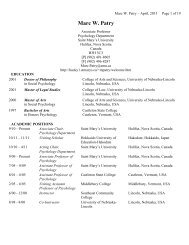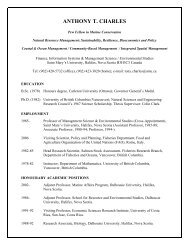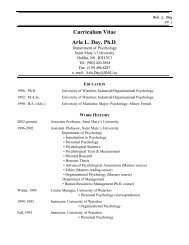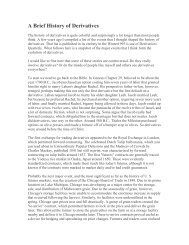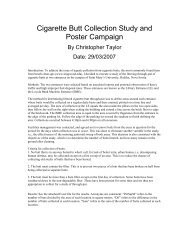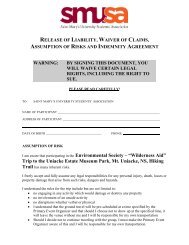MISSIONARIES, XHOSA CLERGY & THE SUPPRESSION OF ...
MISSIONARIES, XHOSA CLERGY & THE SUPPRESSION OF ...
MISSIONARIES, XHOSA CLERGY & THE SUPPRESSION OF ...
- No tags were found...
You also want an ePaper? Increase the reach of your titles
YUMPU automatically turns print PDFs into web optimized ePapers that Google loves.
missionary position in the influential Maclean's Compendium. 21 Claiming that Xhosa beliefsand practices formed 'a regular system of superstition which answers all the purposes ofany other false religion', Warner insisted that missionaries were in error to compare them toisolated superstitions of Europe, such as nailing a horseshoe over the door, and should notbe misled by the fact that Africans had 'no visible symbols' of their supernatural beings.It is the spirits of their departed friends and ancestors, whom they dread, in whomthey trust, and whom they endeavour to propitiate. This is the foundation of that system ofsuperstition.Warner asserted that the igqira formed an 'order of priesthood'. While all missionariesagreed that the igqira and any ceremonies conducted by him or ordered by him were'heathenish', Warner linked customs such as circumcision and intonjane, in which the igqirahad little or no part, with this system of superstition. Warner's position was that there couldbe no piecemeal approach; 'the system itself must be nationally abandoned' and customsin any way associated with this 'system' must be 'denounced and overturned'.Otherwise there will be a danger of building Christianity on the rotten foundations of theirpagan superstition. as the Roman Catholic Missionaries have done in some parts of theworld.Not all missionaries adopted this drastic position. Some argued, for example, thatcircumcision, in itself, is not immoral, nor in any way unChristian. 22 However, they wereprofoundly shocked and opposed to many of the behaviours that were associated with thecustoms and the celebrations: the drinking of beer, 'immoral' dancing and other'immoralities'. 23 Some adopting this position seemed to leave the door open to toleration ofthe customs if the objectionable associated elements were eliminated. However, forothers, the ‘immoral’ associations were too close for the customs ever to be acceptable.Thus, in the public proceedings of the Native Laws Commission, what sounds like prudery,rather than religious objection, was frequently voiced by missionaries. But, of course, it wasnot simply prudery. The objective of missionary work, as the missionaries conceptualized it,was to produce a sober, pious community. This was not simply a recreation of Europeansociety because such a community was not often to be found in Europe, at least on anyscale. In any case, the traditional socializing activities had great appeal to Africans andrepresented a serious threat to missionary endeavours. It is doubtful if any missionariesescaped losing some of their converts when the latter succumbed to the allure of thetraditional social activities and 'backslid'. Thus, even without religious aspects, participationin traditional rites and celebrations involved a 'lifestyle' that was inimical to the 'ljfestyle' themissionaries were trying to engender.In addition, intonjane and lobola were part of a larger missionary preoccupation in thenineteenth century-the 'degraded', 'servile' status and condition of women in African21 All citations from Maclean, ‘Laws and Customs Connected with Their System of Superstition’, A Compendium, pp.78-112. This was a basic source of information for both government officials and missionaries. W.C. Holden quotedlarge sections verbatim in his The Past and Future of the Kaffir Races (London, c. 1866), pp. 182ff.22 Bishop Callaway (Anglican), Native Laws, Minutes of Evidence, appen. C, p. 71. Also, Revd Chalmers(Presbyterian), Native Laws, Minutes of Evidence, appen. C, p. 137, no. 2395.23 They were not very specific, but frequently used terms like licentious. Also, the initiation customs brought thebeginning of ‘sweethearting’ and participation in ukumetse practices by the young people; missionaries found theseunspeakably wicked. The dancing and other activities in the celebrations they argued were an incitement to the youngpeople.
society. 24 24 Inequality of the sexes resulted because lobola 'is based on the idea thatfemales are the property of the father, the elder brother, or the husband, and not equal tothem in any way. The whole social state of Kafir society is therefore built on a wrongfoundation.' 25 'The husband looks upon a woman he had paid ikaz for as a servant.' 26Frequently, strong exception was taken to the division of labour which assigned primaryresponsibility for agriculture to women; as a result, 'women have all the drudgery andlaborious work to perform'. 27 However, Bishop B.L. Key's observation that 'although womenhave to work hard, their position...is as good as that of women in England among theagricultural population', showed that a few missionaries were somewhat less biased. 28Moreover, the introduction of ox-drawn plows was greatly increasing male participation inagricultural activities. 29Their greatest example of 'degradation' was polygyny, and lobola, they felt, was thefoundation of this 'unnatural' relationship. The better, 'natural' feelings of fathers andbrothers were corrupted by cupidity and greed; being valued in cattle demeaned anddemoralized the women. Old, rich men had a distinct advantage over poor, young menwhen such large payments were involved, The large vested interests built up made it verydifficult to disentangle and dissolve such 'sinful' relationships, Revd Chalmers was notopposed to lobola if it were connected with monogamy, but had reservations because ofthe connection with 'polygamy'. 30 Nevertheless, by the time of the Native Laws Commission(1881-3), a few missionaries had begun to see polygyny in a broader perspective. SomeAnglicans felt that if polygyny were suppressed, a much worse evil, 'concubinage', wouldresult. Even if polygynous, ‘the native marriage is a marriage, and entails responsibilities ona husband, though different from those in Christian marriage’, 31 and ‘the wives have arespectable status’. 32 The Revd Bertram (a retired, Wesleyan Methodist) felt that polygyny‘was a hindrance to Christianity’ but, he went on, 'there are advantages; whilst they live intheir native state I know of no great disadvantages.' The main advantage that he noted wasthat 'it reduced the number of children of a woman'. 3324 See Etherington, Chapter 7 in this volume, for additional evidence.25 Revd T. Weiz (Moravian), Native Laws, appen. C, p. 216.26 Revd W.H. Turpin (Anglican), Native Laws, Minutes of Evidence, p. 164, no. 2789.27 J.C. Warner, Compendium, p. 72.28 Native Laws, appendix C, p. 186, no. 31. Most missionaries seemed unaware that unflattering comparisons could bemade with the drudgery of working-class women in the mines, in the factories, and in the homes of the wealthy inBritain.29 In fact, the division of labour, which prohibited females from contact with cattle, could work the opposite wayaccording to Revd Brownlee Ross. Ross encouraged men without sons to use daughters to help drive ox teams;however, the one man who tried it was soon forced to stop by the reactions of his scandalized neighbours. Imvo (29 Apr.1903).30 Native Laws, Minutes of Evidence, p. 155, no. 2645-6; see entire testimony, pp. 137-55.31 Revd Key, Native Laws, appen. C, p. 187. See also Archdeacon Waters, Minutes of Evidence, pp. 358-64 and appen.C, pp. 169-70; Revd Thomas Green, Minutes of Evidence, pp. 390-1.32 Bishop Callaway, Native Laws, Minutes of Evidence, pp. 404, no. 7272. Although he says ‘polygamy is a great evil’(p. 405), in his testimony (pp. 402-5 and appen. C, pp. 72-8), he reveals more understanding of what polygyny meant toAfricans than did the majority of missionaries. This seems to represent a significant shift in his approach from 1862when he published a pamphlet, Polygamy a Bar to Admission to the Christian Church, repudiating Bishop Colenso’smore tolerant attitude. Callaway never went as far as Colenso but his testimony seems to indicate that he had swungaround to quite a few of Colenso’s arguments by 1881. See M.S. Bentham, Henry Callaway, First Bishop of Kaffraria(London and New York, 1896), pp. 134-45.33 Native Laws, Minutes of Evidence, p. 309, no. 5526-29. However, Revd Weiz seemed to regard fewer children as anindication of inefficiency. ‘Polygamy is not even expedient, as far as fruitfulness is concerned. Jacob with four wiveshad not more children than many a monogamist and upon the whole, even among the Kafirs, the number of children issometimes small, considering the number of wives.’ Appen. C., p. 216.
The most tolerant approach on the question of the status of women and traditionalcustoms generally, had been that advanced by Bishop Colenso in the early 186Os. HenryCallaway, Anglican Bishop of St John's (Transkei), but former associate of Colenso andregarded as a Zulu expert, brought that greater tolerance, or at least caution, to the CapeColony. In regard to intonjane, the traditional custom for which missionaries urged forciblesuppression by law most frequently (although circumcision was a fairly close second), 34Callaway said before the Native Laws Commission:'Intonjane' is attended with customs which appear to us destructive of female modesty, butwe are not sufficiently well acquainted with it, probably, to understand it. It has been afashion to denounce practices with which we are not acquainted, and to be in a hurry to urgelegislation against names, without our understanding the things themselves. 35Revd W.A. Goodwin (Anglican) restated the Colenso argument very forcefully at aMissionary Conference in 1904. He argued that polygyny was a sin of the missionaries'own making as it was prohibited nowhere in the Bible.Before either consigning to perdition or withering with so-called righteous indignation, theadvocates of tender handling, at least look patiently at the other side of the question,remembering that even though we may be prejudiced, Truth itself is many-sided, and thatthere is no need to add to the multitudinous sins of humanity fresh sins which our zeal andfervour have themselves created. 36In spite of the negative consequences of breaking up polygynous marriages, mostmission societies insisted that men put away all wives except the first before they could beaccepted into membership, and that women must leave polygynous relationships beforethey could be accepted. Anglicans were moderately less strict. Because a woman wasregarded as 'involuntarily' linked and lacking 'power over her own body', she could bebaptized and confirmed. A male polygynist could not be admitted to full membership, but itwas felt undesirable to urge him to send his wives away as 'it is quite possible that otheroffences against the moral law, natural and Christian, of a graver character than evenPolygamy, may be committed by requiring a polygamist to put away his wives, without theirconsent and due consideration of their legal status and claims.' 37 Thus, polygynists weretaken under instruction as 'catechumens' 'until events release him from moral obligations orcovenants entered into before he was acquainted with Christian doctrine’. 3834 The Anglican Archdeacon Waters forbade intonjane on St. Mark’s mission station but allowed circumcision (NativeLaws, Minutes of Evidence, p. 358, no. 6401) and advocated legal suppression only of intonjane (appen. C, p. 168).35 Native Laws, appen. C, p. 71.36 Report of the Proceedings of the First General Missionary Conference Held at Johannesburg…1904 (Johannesburg,1905), p. 100. However, Bishop Alan Gibson, while admitting all the problems and difficulties posed by taking a hardline, concluded that the need to maintain church principles in regard to marriage and baptism required an insistence onno compromise. See his ‘Polygamy and Christianity in South Africa’, East and West, V (1907), pp. 135-50.37 Bishop Callaway, Native Laws, appen. C, p. 73. Not only was this felt to be disruptive and a shirking off ofresponsibility, but it was recognized that women sent home in this way were unlikely to be remarried and in most caseswould become idikazi. These women had only impermanent liaisons and had no permanent claims on the fathers of theirchildren. Thus, the sending away of wives would lead to much more ‘concubinage’, ‘prostitution’ and ‘immorality’.38 Bishop Key seemed to feel the need to justify this approach as he several times defended it in letters to MissionChronicle; especially the touching story of Thomas Ntaba:‘Then he told us of a talk he had with the second wife…she…said, “Do as you will, but I cannot leave you; I love you.”And he told us, “I cannot leave her; she must remain my wife.” I cannot think we have given way weakly tocompromising our Christian calling when we told him we would admit him as a learner… On the one hand there is thesanctity of baptism, on the other the sanctity of family life -even the family life of a polygamist. Rash hands may not
The more accompanying approach of Anglican missionaries from Natal andZululand, as noted above, is interesting and revealing. First, it was not shared by theircolleagues in the Diocese of Grahamstown. When St John's Diocese was created in theTranskei out of parts of each, that division on this issue remained into the twentiethcentury. 39 However, it also illustrates a more significant feature of missionary attitudes-theinfluence of peer pressure and conformity. Missionary activity by Anglicans did not begin onany significant scale until about mid century. Anglican missionaries beginning mission workfound very different situations in Natal and in the Cape Colony. In the Cape, they found amission field in which the parameters were already firmly fixed. Moreover, many of theAfrican associates-teachers and later clergy-were educated in other mission societies'schools (especially Moravians). As we shall note, these Africans tended to be outspokenlyopposed to the more accommodating approach. Thus, the missionaries in the earlydecades in the Cape had established norms which later missionaries tended to accept orperhaps found difficult to change. In Zululand, on the other hand, very little had been done.The American Board had been active for some years, but until the defeat of the Zulu state,little progress could be made. As a result, Natal was close to a virgin state in regard to missionwork and a missionary such as Colenso was less trammelled by preconceptions andestablished norms.African clergy were often in no position to take an independent stand on these issues. Inthe first place, one of the criteria for selection was opposition to traditional customs, asRevd Barren (Wesleyan) pointed out in a paper on the creation of a 'native agency':As our work is to reclaim the people from heathenism our helpers should be those who arethoroughly staunch in their opposition to all superstitious customs, barbarous and filthy practice,and I would add beer drinking. They should be men who having been set free by Christ, detestthe heathen rite of circumcision and who believe that women having been redeemed with theprecious blood of Christ are not any longer to be bought and sold. 40African clergy were expected to enforce the rules and were themselves disciplined for anybreaches of the rules. In 1881, the Wesleyan Methodist clergy, James Lwana and AbramMabula, were disciplined for accepting lobola for their daughters. 41 As a result of a report inthe Cape Mercury (6 December 1884), Mabula was accused, in 1885, of paying lobola onthe marriage of his son. Although very dissatisfied, the missionaries were unable todisprove Mabula's contention that the payments were only 'presents', not lobola. 42 It is notclear what the inflexible missionaries felt that parents should do when the parents of a girlwhom their son wished to marry insisted on lobola, or what a young man in such a situationshould do. In the case of circumcision, proposals to discipline parents of boys who wentthrough the rite were never applied. Even the missionaries conceded that parents wereunable to prevent determined young men. However, one of the charges levelled againstNehemiah Tile, just before he withdrew from the Wesleyan Methodist Church, was that hehad contributed an ox for the circumcision of the Thembu paramount's heir, Dalindyebo. 43touch it in any form; we must deal gently even with this form of family.’ Mission Chronicle, new ser., I, 10 (1899), pp.302-3.39 Mission Chronicle, new ser., I, 8 (1898), p. 234.40 Methodist Archives, Cory Library, MS 15, 711(b).41 Methodist Archives, MS 15, 018, Minutes of the Grahamstown District Meeting, 1881.42 Methodist Archives, MS 15, 192, Minutes of Queenstown Native District Meeting, 1885, pp. 425-6. Cape Mercury, 6Dec. 1884.43 C.C. Saunders, ‘Tile and the Thembu Church: Politics and Independency on the Cape Eastern Frontier in the lateNineteenth Century’, Journal of African History, XI, 4 (1970), p. 556.
Moreover, many early clergy were convinced by and indoctrinated into the missionaryview. The idea of 'progress' was strongly inculcated and, for Africans, frequently that meantabandonment of traditional customs in favour of European customs. In a paper in 1877,P.J. Mzimba pointed out some practical 'evils' of lobola. 'This bleeding of young men'prevented their getting married, with resulting immorality, or caused desperate unmarriedgirls to go to great extremes in adorning themselves in order to attract husbands. Also, as aresult, young couples started marriage with nothing or with heavy debts; this was very bad,even fatal, for the marriage; at the very least, young couples were unable to build a properhome with decent furniture. 44 As a result, even though lobola was not condemned assinful, it was regarded as 'outmoded' 45 or as 'a remnant of heathenism'. 46 Peter Masiza(Anglican) was violently opposed and even urged that lobola be suppressed by thegovemment. 47 Masiza also maintained an adamant opposition to circumcision. 48 In fact, asnoted earlier, African clergy in St John's Diocese adopted the more rigid position ofGrahamstown Diocese on circumcision and traditional customs. 49Nevertheless, African clergymen were still part of the traditional 'world' of Xhosa societyand culture. As a consequence, they had, in spite of themselves and of missionarypressures, an inherent appreciation of many traditional values (even J.H. Soga at timesbecame lyrical in descriptions), and occasionally they expressed uneasiness. In 1885,Gana Kakaza, in a paper to the Healdtown Teachers' Association, displayed uneasiness:It is my deeply-rooted fear we are in danger of throwing away as useless ever custom thatobtained among our forefathers, and of adopting every European custom as being right simplybecause it is European in its origin.While the Europeans brought Christianity, they also brought liquor. 'I say, therefore, let usbeware of what we are about.' 50Isaac Wauchope 51 went even further and launched a significant counter-attack againstthe unrelenting denigration and disparagement of traditional culture and customs. In 1891,he argued forcefully that much more effort should be devoted to teaching Xhosa in the'Native Institutions'. 52 Subsequently, he began to collect amaqalo-mottoes or proverbs-andin November he thanked those who had been sending him examples.44 Christian Express, VII, 84 (1 Sept. 1877), pp. 14-15. The writer of Imvo’s sub-leader (8 Aug. 1894), probably Jabavu,adopted a similar position. ‘We…favour the European mode of building up the home of the new couple to our nationalmode of denuding it at the very start with concomitant evils.’45 Imvo, 15 Dec. 1892.46 Revd Rubusana, Christian Express (1 Dec. 1905), p. 189.47 Christian Express, II, 19 (1 Apr. 1872).48 Bishop Key described his views in 1898. ‘Mr. Masiza would have none of it. The thing was bad, and must beextirpated root and branch. He would have no treaty with this old enemy of Christianity…he hailed this new proposal[to impose discipline] as a return to the right path, over the leaving which he had mourned.’ Mission Chronicle, new ser.,I, 8 (1898), p. 234.49 Mission Chronicle, old ser., V, 53 (1890), pp. 115-16.50 Imvo (20 May 1885).51 Wauchope had a fascinating career. In 1877, he was one of four African volunteers to accompany the Revd DrStewart to found the Livingstonia Mission in Malawi. He returned to the Cape in poor health after a few years. Afterteaching at Uitenhage where he was recuperating, he was appointed court interpreter in Port Elizabeth. There, he wasvery prominent in the African community. In 1888 he entered the Theology School at Lovedale and was ordained in1892 in the Congregational church. In addition to his ministerial duties at three congregations in the Fort Beaufort area(which included supervision of several schools also), he was active in parliamentary elections and the Native CollegeScheme. In 1909, he ran afoul of the law, see Imvo (29 Dec. 1909; 25 Jan., 1 Feb. 1910). During World War I hevolunteered for the Native Labour Contingent and was one of the victims of the Mende disaster.52 Imvo (16 and 23 July 1891). The paper provoked some dissent and controversy flickered on for some weeks.
There is a tendency in the Native mind to regard civilized moral standards as foreign orstrange. My object is to show that corresponding moral standards exist in crystallized formsin their own National Mottoes, and that by living up to those they would not fall far below thecivilized standards of morality. 53In 1901, in a short series entitled ‘Primitive Native Customs: Their Moral Aspects’,he strongly defended traditional customs. In the article on circumcision, he referred to theantiquity of the custom, to its place in the Christian Bible and to hygienic benefits. However,it was the disciplinary features that he emphasized. The transition from boyhood tomanhood is a critical period and one of anxiety to parents; the discipline is necessary in thetransition, 'to rid the lad of his boyishness'. The initiate learns to be hardy and plucky underpain, and during the seclusion he forms new ideas of duty and of life, of order and ofroutine. A sense of social order is also instilled, as the first boy cut is first in everything, andeach boy must keep his place and turn. Athletic exercise is also an important part of thediscipline, and the abakwetha dances are part of this exercise as 'all the muscles of thebody are brought to play'. Finally, the lectures after the removal of the white clay areimportant and impressive moral teaching in which 'the topics are manliness, bravery,sobriety, chastity, honesty, modesty, obedience'. On the other hand, 'all that is immoral andbase in the rite is the result of corruption in later innovations'. 54On the issue of lobola, Wauchope, along with other African clergy, showed a great dealof ambiguity. He noted four benefits of 'ethical significance' from the custom:1. …first, that by it the social dignity of the wife is assured.2. It provides a guarantee for the good treatment of the wife by her husband andhis people.3. It forms a safeguard against immoral conduct and is an encouragement tochastity-a source of material benefit to parents.4. It encourages industry, as the lazy man would have no wife, because he wouldhave no cattle unless he worked.However, there was an underlying assumption that eventuaIly new, better safeguardswould replace these as people acquired education and 'civilization'. 55African clergy were aware that, from the African point of view, the European model ofmarriage without lobola had a number of deficiencies. Before the Native Laws and CustomsCommission, some of Mzimba's church members argued that 'many of our girls who havebeen married without lobala [sic] have been left destitute by their husbands. Without lobola,a man did not feel properly married and was more likely to abandon a woman.' 56 As ElijahMakiwane and P.J. Mzimba testified in the presence of their mentor (the Revd Dr Stewartwas a member of the Native Laws Commission), in the Free Church of Scotlandmembership was not denied to persons who practiced lobola: ‘the way we deal with it issimply to tell the people what we think of it.’ 57 However, the ambiguity went much deeper.Throughout the questioning, Makiwane was contradictory. At one point he was asked hisopinion of the custom and he replied, ‘In itself, I do not think it is a bad one.' However, afterbeing pressed and thrown on the defensive, he contradicted himself and declared that ‘it is53 Imvo (15 Nov. 1891).54 Imvo (4 March 1901).55 Imvo (6 May 1901).56 Native Laws, Minutes of Evidence, pp. 100-1.57 Ibid., p. 108.
ad because some of the parents do not look so much to the comfort of their daughters asto the number of cattle they receive'. Still later he denied that fathers consider only thenumber of cattle. 58 Two Congregational clergymen, Walter Rubusana and GwayTyamzashe, showed the same ambiguity. Both vigorously denied that lobola was apurchase and defended its intent; both also declared that it was a heathen custom andshould be discouraged. 59 Moreover, the pressure of family could be irresistible. Theproblems faced by Abram Mabula when his son wished to marry were noted above. JamesJolobe (Presbyterian and briefly DRC clergyman) strongly opposed lobola, but his sonsinsisted that he ask for lobola because they had had to pay lobola and contribute to theoutfitting and wedding expenses of their sisters. 60<strong>THE</strong> ATTENUATION <strong>OF</strong> OPPOSITIONGradually, missionary opposition to lobola weakened. There were a variety of reasons forthis. Attempts to eradicate it brought worse 'evils', especially hypocrisy, either by outrightdeception or by arguing that cattle being transferred, sometimes in the dead of night, werenot ikhazi but merely 'presents'. Because of this concern, as early as 1862 the Moravianmissionaries ceased to excommunicate those who asked for or received 'presents'. 61Another evil asserted by some missionaries was that without the incentive of lobola, parentslost interest in the preservation of their daughters' virginity, with a consequent increasein immorality. 62Moreover, some missionaries recognized that the view that women were simply chattelswas not compatible with reality. In fact, because of lobola, John Chalmers asserted that,'The men are completely at the mercy of their wives... The result is that the men play thesycophant to their wives, and allow them very much of their own way.' 63 Revd Brownlee J.Ross, a third generation Presbyterian missionary, showed a more accurate view of the statusof women in Xhosa society and of the 'insurance' functions of lobola. Writing to theScotsman just after the turn of the century, Ross declared that Xhosa women 'have a muchbetter legal standing than thousands of women in Europe, and are better treated, andcases of wives [sic] assault are less common in Kafirland than in Scotland.' 64 While Rosswent much further than was typical, his comments are indicative of a change in missionaryattitudes; lobola came to be accepted as not being incompatible with Christianity. 65 By theend of the century, all the older mission bodies had ceased to treat it as a disciplinarymatter. Even the Methodist church, which had been the most adamantly opposed and58 Ibid., p. 107, no. 1767-71 and passim.59 Tyamzashe, Native Laws, appen. C, p. 153; Rubusana, Christian Express (1 Dec. 1905), p. 189.60 Interview, Revd J.J.R. Jolobe (son), 28 July 1972.61 Revd Weiz, Native Laws, appen. C, p. 216. Anglican missionaries advanced this as one reason for not opposinglobola; it is clear that many Presbyterians were ignoring lobola, even though opposed to it, and for much the samereason.62 Anglicans especially advanced this argument. Lobola was seen as the only check to a threatened torrent of sexuality,as ‘a preventive to absolute license between the sexes’, as Revd Key phrased it in Native Laws, appen. C, p. 187, no. 52.63 Chalmers, Tiyo Soga, pp. 1-2.64 Reprinted in Imvo (29 Apr. 1903). In this article on lobola, ‘the old, old story of Kafirs buying wives and makingslaves of them’ was dismissed as ‘the old, old lie …the men who know Native laws, customs, traditions, and languagebest are pretty well agreed that the paying of dowry is a good custom.’ J.H. Soga later even further described lobola as‘The Bantu Woman’s Charter of Liberty’, Ama-Xosa, pp. 274-5. Soga is, of course, impossible to categorize because hewas both Xhosa and Scottish.65 However, missionaries arriving under the sponsorship of fundamentalist churches and bodies adopted the oldperspectives and condemnation of lobola.
most vigorous in imposing discipline, changed its rules sometime after 1894. 66On ukwaluka or circumcision, the outcome was very similar. Missionary opposition wasstrong throughout the nineteenth century (many missionaries testifying before the NativeLaws Commission had even advocated that it be made illegal). Generally, boys who wentthrough the rite were expelled from school and disciplined in the church. However, if theysubsequently 'repented', they were allowed to return. The missionaries faced a dilemma:these young men were their biggest hope for the future and they realised that wouldshackle their own prospects if they tried to make their disciplinary sanctions permanent. 67Tiyo Soga was unusual in refusing to undergo the rite. This lack posed problems for hisministry years later, as Xhosa were contemptuous of, and not inclined to listen to, anuncircumcised male.In any case, with regard to circumcision, missionaries were confronted by a stone wall.B.A. Pauw describes it as 'the traditional institution most tenaciously adhered to by theurban Xhosa-speaking people'. 68 In fact, the 'spreading of the custom to tribes who do notat present practice it, for example, Bhaca and Mpondo, is a fairly general phenomenon inthe Transkei'. 69 The churches and mission societies had to compromise, at least to theextent of disciplining only attendance at a 'heathen circumcision school', and often formalbanns were rescinded only in the inter-war period. Frequently, the rite was little more thanthe physical operation itself; even among non-Christians, the special costumes andabakwetha dancing died out during the 1920s and 1930s, and the seclusion period becamemuch shorter. 70There were several factors behind this resistance to the missionaries' attempts toeradicate circumcision. The Xhosa had an almost mystical belief in the value of, and needfor, the transformation brought about by the rite, and the young men were subjected tointolerable pressures. Even when parents desired it, they could not prevent their sons fromundergoing the rite. This inability to control their sons extended to clergymen as well. RevdJ.J .R. Jolobe said that he and his brothers had all, under the guise of visiting relatives,arranged to be circumcised and had been so successful in hiding the fact that their father,Revd James Jolobe, did not learn about it until years later. 71 Mr Zizi Mazwai said that heand his brothers had also quietly arranged operations at a hospital, in spite of the RevdAmbrose Mazwai's denunciation of the custom. 72 Thus, circumcision was such a coreinstitution in the identity of the Xhosa-speaking people that no policy, action or sanctionwas of any real effect. The only result of the missionary campaign was to promotedeception, breaches of discipline, disobedience of children, and hypocrisy.In the case of intonjane, the missionary campaign at first blush appears to have been a‘success’; it has pretty well died out, for traditionalists as well as Christians. But the66 I am not certain exactly when the Methodists changed their policy, but a very interesting article in Imvo (8 Aug. 1894)seems to indicate that change was taking place then. Imvo under its very active Methodist layman, Jabavu, hadconsistently condemned the custom; as late as 10 Jan. 1894, it called lobola ‘a heathen practice’ which must beabolished. Just eight months later, Imvo said that it was a very much misunderstood custom which used to be prohibitedas a sin, but ‘the question has been reopened and is being discussed by Native Christians under present day light’. Thisstatement seems to indicate that the pressure for the change was coming from Africans.67 Fighting and trouble in the mission schools was almost endemic as boys who had undergone the rite used inkwenkewor similar disparaging forms of address with those who were not.68 Pauw, The Second Generation (Oxford, 1963), p. 88.69 Hammond-Tooke, Bhaca Society, p. 82.70 For descriptions and evaluations of the rite in recent times, see Pauw, The Second Generation, pp. 88-94; M. Wilson,et al., Social Change, pp. 199-220.71 Interview at Lovedale, 28 July 1972.72 Interview at Healdtown, 14 June 1972.
missionary campaign was, at best, a contributing factor rather than a determining one.African fathers frequently tried to avoid its burdens and other objections were tending tobring a decline in its observance in any case. A further qualification is that modernanthropologists have found many similar elements frequently incorporated into Christianmarriage ceremonials. Just prior to her wedding, the bride goes into seclusion, very likethat of the intonjane, for up to two weeks. This is concluded by a feast-often called aparty. 73 Thus, a good deal of the meaning and intent of intonjane appears to have beensynthesized into Christian marriage practices.CONCLUSIONThese campaigns were only part of a more general struggle-the effort to root out traditionalreligion, their 'system of pagan superstition' as Warner had called it, and to put Christianityin its place. The belief in the family ancestral spirits and in the efficacy of their influence inthe lives of the living was the most important element of that traditional religion. Theprimary concern of the ancestors was that the living members of the family should adhereto and perform the traditional customs. The ancestral spirits punished failure to performtraditional customs; but if they were pleased, they protected the family, its animals and itscrops from the malevolent influences and evil medicines (witchcraft) of enemies andjealous neighbours. However, much of this was implicit rather than overt. Only when anigqira (diviner) was involved was much explicit. In normal practice, all Xhosa understoodthat the ancestors were pleased when customs were performed and when meat wasoffered, even though there were no overt invocations. To observers it could appear to benothing more than a feast. There was no way for missionaries to monitor the meaningswhich could be attributed to any killing or feast in the minds of the participants. Churchdiscipline could be visited on the overtly religious act, but could not touch the implicitreligious thought. In view of this, it seems likely that church discipline probably tended tosuppress external and open practice without necessarily destroying or eliminating beliefsand implicit practices.Modern researchers have found that Xhosa Christians do retain a great deal of belief inthe ancestors and in their effects on the living. 74 Pauw reported high proportions ofChristians who had received messages from their ancestors. He also reported a new'unveiling the tombstone' ceremony. This ceremony has a high degree of similarity with,and incorporates almost all the essentials of, the traditional ukubona umzi or ukubuyisaceremony. 75 This seems to indicate that, to a large extent, Christianity was accepted inaddition to, rather than in place of, traditional religious beliefs. Pauw explained this byarguing that Xhosa Christians compartmentalized. The ancestors had a role and interestalmost exclusively within the family and in regard to domestic concerns, while Christianitywas believed to be more relevant and of greater significance in the wider economic andpolitical life of modem South Africa.One other factor in toning down the missionary campaign against traditional customs73 Wilson, Reaction, pp. 214-6, 530; M. Wilson et al., Social Change, p. 152; Pauw, The Second Generation, p. 94; W.D.Hammond-Tooke, Bhaca Society, pp. 82-6 and The Tribes of Mount Frere District, Ethno. Pub. No. 33 (Pretoria, c.1955), p. 53.74 B.A. Pauw, Christianity and Xhosa Tradition, (Oxford, 1975), passim; W.D. Hammond-Tooke, Bhaca Society, p. 236.75 After the death of a homestead head or chief (time could vary from six months to three years), this ceremony broughtthe mourning period to an end, completed the process of purifying the family, and facilitated the passage of the deceasedto join the ancestors. There are sketchy accounts in Wilson, Reaction, p. 230; Hammond-Tooke, Bhaca Society, p. 231;Soga, The Ama -Xhosa, p. 322.
was the emergence of religious separatism. It is difficult to quantify how much influence thishad, but it could hardly have been a coincidence that the emergence of religiousseparatism and the waning of the missionary campaign occurred at the same time.However, I do not think it was the major factor. To turn it the other way around, religiousseparatism was not driven primarily by the urge to continue performing traditional customs,because most Xhosa Christians had continued to do so anyway. Missionaries had alwayshad to compromise or, in some cases, to turn a blind eye. With religious separatism,missionaries became even more aware of the need to avoid provocation. The missionarieshad had inflated ideas about what conversion could mean in terms of cultural and socialadaptation. What they had been forced to recognize was that in conversion there werelimits on how much could be dictated in adaptation to Christianity.



